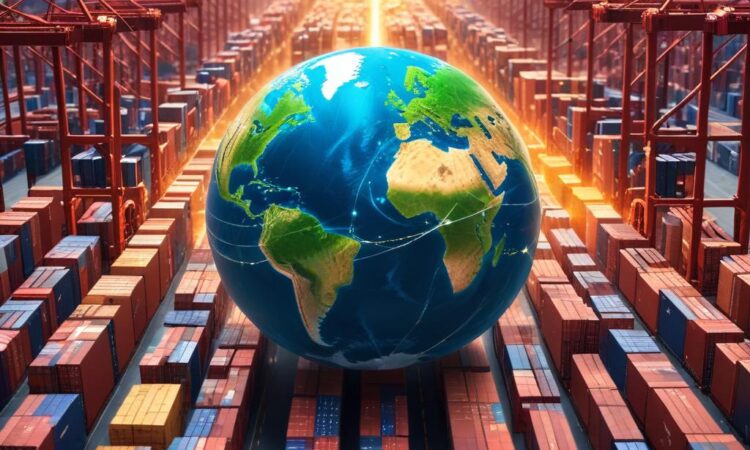Impact of the US-China Trade War on the Global Economy
The recent US-China trade war is having a significant impact on global supply chains, consumer prices, and investor confidence. This development is covered extensively in the Financial Times, the Wall Street Journal, the Peterson Institute for International Economics, and the World Trade Organization reports.
The initial mechanism of impact stemmed from the imposition of tariffs on billions of dollars worth of goods traded between the two largest economies in the world. These tariffs, designed to protect domestic industries and leverage economic pressure, have resulted in a complex ripple effect throughout the global economy. The initial impact was felt most acutely in sectors directly involved in trade between the US and China, such as technology, manufacturing, and agriculture. However, the repercussions have extended far beyond these sectors, impacting almost every aspect of global trade and finance.
Impact on Specific Sectors
Technology Sector:
The technology sector has been particularly hard hit. The trade war has led to increased costs for technology companies reliant on components and manufacturing facilities in China. This has resulted in higher prices for consumers and decreased profitability for many firms. The uncertainty surrounding future trade policies has also hampered investment in research and development, slowing innovation in the sector. Furthermore, the restrictions placed on the transfer of technology between the two countries have created significant challenges for technological advancement on a global scale.
Manufacturing Sector:
The manufacturing sector, especially in countries deeply integrated into global supply chains, has experienced significant disruptions. Companies have faced increased costs due to tariffs, leading to higher prices for consumers or reduced profit margins. Some manufacturers have relocated production facilities to avoid tariffs, leading to job losses in some regions and job gains in others. This geographical shift in manufacturing capacity has created new geopolitical complexities and challenges for policymakers.
Agricultural Sector:
The agricultural sector, particularly in the US, has faced significant challenges due to retaliatory tariffs imposed by China. Farmers have experienced reduced export revenues, leading to lower farm incomes and economic hardship in rural communities. The uncertainty surrounding future trade relations has also impacted investment decisions within the sector, further compounding the negative effects. Government subsidies have attempted to mitigate some of the damage, but the long-term consequences remain uncertain.
Impact on Specific Regions
East Asia:
East Asia, heavily reliant on trade with China and the US, has been significantly impacted. Countries like South Korea, Japan, and Taiwan have seen their exports affected by the reduced trade volume between the two major economies. The decreased demand for intermediate goods has also disrupted regional supply chains, highlighting the interconnectedness of the global economy.
Southeast Asia:
Southeast Asian economies, while initially benefiting from some relocation of manufacturing, have also faced challenges. The increased uncertainty and the potential for further escalation of the trade war have dampened investor confidence and hindered economic growth. The region’s dependence on exports makes it particularly vulnerable to fluctuations in global demand.
Europe:
European economies have also experienced indirect impacts. Reduced trade between the US and China has led to a decrease in global demand, impacting European exports. The uncertainty surrounding the trade war has also reduced investor confidence, leading to lower investment and slower economic growth. The EU has attempted to mitigate some of these negative impacts through diversification of trade partners and increased internal market integration.
Global Economic Consequences
The US-China trade war has had a significant impact on global economic growth. The International Monetary Fund (IMF) and other international organizations have revised their global growth forecasts downward, citing the trade war as a major contributing factor. The uncertainty surrounding trade policies has also reduced investor confidence, leading to decreased investment and slower economic growth worldwide. The decreased trade volume has also disrupted global supply chains, increasing costs and reducing efficiency.
The Role of Investor Confidence
The trade war has significantly impacted investor confidence. The uncertainty surrounding future trade policies has led to volatility in global financial markets and decreased investment in new projects. This decreased investment has further slowed economic growth, creating a negative feedback loop. The lack of predictability in the international trading environment has made it more difficult for businesses to plan for the future, hindering long-term investments and economic expansion.
Long-Term Implications
The long-term implications of the US-China trade war are still unfolding. The potential for further escalation remains, and the consequences for the global economy could be significant. The trade war has highlighted the interdependence of global economies and the potential risks associated with protectionist trade policies. The long-term impact will depend on the eventual resolution of the trade dispute and the response of governments and businesses to the challenges it has created. There’s potential for lasting shifts in global supply chains, increased regionalization of trade, and a reshaping of geopolitical alliances.
Potential Solutions and Mitigation Strategies
Addressing the negative consequences of the trade war requires a multifaceted approach. Negotiated settlements and a return to multilateralism are crucial for reducing trade barriers and restoring stability to the global trading system. International cooperation is essential for resolving disputes and promoting fair trade practices. Moreover, governments can implement policies to support affected industries and workers, such as retraining programs and financial assistance. Increased transparency and predictability in trade policies are also crucial for boosting investor confidence and encouraging long-term investments.
The future trajectory of the global economy will depend greatly on how effectively governments and businesses adapt to the challenges posed by the US-China trade war. A collaborative and forward-looking approach is crucial for mitigating the negative consequences and building a more resilient and sustainable global economic system.
This analysis is a snapshot of the situation at a particular point in time. Further research and analysis are necessary to fully understand the long-term impacts of the US-China trade war on the global economy.

